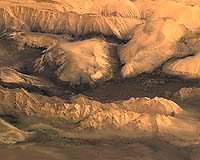 |
Berlin, Germany (SPX) Nov 15, 2010 They say you can't judge a book by its cover, but with planets, first impressions do count. New images from the German Aerospace Center operated High Resolution Stereo Camera on the European Space Agency's (ESA) Mars Express spacecraft show where complex fault lines in the Red Planet's Phoenicis Lacus region have resulted in terrain with a distinctly contrasting appearance. Nineteenth-century astronomers were the first to see Phoenicis Lacus on Mars. They identified it as a dark spot, and thought that it resembled a sea. Now we know that it is not a body of water but the southwestern extension of the complex Noctis Labyrinthus system, which stretches away from the giant volcanoes of Mars's Tharsis region. Even today, the brightness of a surface feature is the first thing planetary astronomers notice. It is known as the albedo and is partly determined by the composition of the surface material; for example, ice is more reflective than rock. The texture of the surface also plays a part, with rough surfaces reflecting less sunlight and so appearing darker than smooth surfaces. Phoenicis Lacus spans an area of 8100 square kilometres (59.5 x 136 kilometres), roughly the size of Corsica. Only a small portion of it appears in this image, which was obtained on 31 July 2010 using the High-Resolution Stereo Camera (HRSC) on ESA's Mars Express spacecraft. Phoenicis Lacus was formed by the uplift of the Tharsis plateau. The continual episodes of strong volcanic activity in Tharsis not only lifted the plateau, but also deformed Phoenicis Lacus, creating blocks and multiple fault lines at different orientations. Extension has taken place here, resulting in this characteristic 'horst-and-graben' (cliffs and valleys) landscape. A prominent collapse feature is also visible in this region. It shows as a long pit and sinks to a depth of about 3 kilometres below the surrounding plains. Its walls give a glimpse of extensive basalt layers and a small field of sand dunes covers the floor.
Share This Article With Planet Earth
Related Links Mars Express Image Browser Mars News and Information at MarsDaily.com Lunar Dreams and more
 Melas Chasma On Mars: As Low As One Can Go
Melas Chasma On Mars: As Low As One Can GoBerlin, Germany (SPX) Oct 13, 2010 There are few places on Mars lower than this. The floor of Melas Chasma sinks nine kilometres below the surrounding plains. New images from the German Aerospace Centre (Deutsche Zentrum fur Luft- und Raumfahrt; DLR) operated High Resolution Stereo Camera on ESA's Mars Express orbiter highlight the complex history of this enormous martian canyon. Melas Chasma is part of the huge Valles Mari ... read more |
|
| The content herein, unless otherwise known to be public domain, are Copyright 1995-2010 - SpaceDaily. AFP and UPI Wire Stories are copyright Agence France-Presse and United Press International. ESA Portal Reports are copyright European Space Agency. All NASA sourced material is public domain. Additional copyrights may apply in whole or part to other bona fide parties. Advertising does not imply endorsement,agreement or approval of any opinions, statements or information provided by SpaceDaily on any Web page published or hosted by SpaceDaily. Privacy Statement |